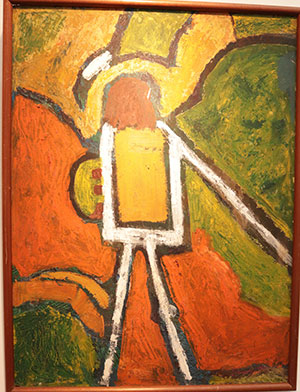IN the light of the recent independence celebration, I decided to focus on an artist whose work displayed themes based on his experiences while in Guyana. Ron Savory was a St Lucia-based Guyanese artist. Savory studied art under E.R.Burrowes at Queen’s College in the 1950s. He later joined Burrowes’ Working People’s Art Class producing small paintings.
Savory was later appointed a civil servant to the District Commissioner’s Office at Kamarang in the Mazaruni. His experience with the Indigenous people would soon influence his work. He started to create paintings which represented the life and culture of the Indigenous people. Depicting the canoes by the creek, riversides, hunting, the Timehri symbols, and the rainforest, he experimented with sand to create textures on a flat surface. Savory soon shifted his focus to the forest itself, attempting to capture the effect of sunlight within the forest. His colour palette often consists of greens, yellows and browns.

Today I’ll be discussing two of his acrylic paintings – Bowman 1967 and Creek 1968. These paintings represent his experience in the Mazaruni. The Indigenous people lived by hunting and fishing, so it is no surprise that Savory’s work displays this lifestyle. A bowman is a person who shoots with a bow and arrow. As you look at the Bowman painting, you can see a standing figure in the centre.
His structure showcases two characteristics of a bowman – speed and silence, that is, he must tread lightly enough so as not to alarm the prey and be fast enough to catch it. Savory uses simple shapes in his composition. It is arranged somewhat like a puzzle with dark brown lines separating each piece. The rustic brown, in my opinion, represents the forest floor. The variety of greens represents the forest. The bright yellow represents the opportune time to hunt. It is simple yet complex.
Creek is such a captivating painting. Its dark colour palette captures the mystery of the forest. I wonder if it’s a night scene or if it speaks to the density of the forest where little to no light can enter. I’m fascinated by the lack of detail in the trees. However, the technique he uses creates movement and even adds depth and distance. There are visible brush strokes in the foreground and a wash (a visual arts technique resulting in a semi-transparent layer of colour) in the background. The still and murky water gives the impression that the forest is somewhat dangerous and uninhabited.

There is no physical presence of forest creatures, but you could imagine hearing their sounds through the painting. A scene like this could never be in silence. It’s the thought of the sounds that adds to the viewer’s experience of the painting. As I take a closer look, I see a hint of brown with a white border that takes the shape of a canoe. The canoe, perhaps abandoned by a lost lone traveller, is resting at the side of the creek in front of some broken branches. There is so much mystery and wonder in this painting. I imagine placing myself in the centre and disappearing if only for a moment.
Art creates an escape from the world as we know it. It isn’t until you experience a piece of work, that you can fully appreciate its power and influence in your life.
The National Gallery would usually hold an Independence exhibition every year featuring works from within the National collection. This year’s featured artists include Stephanie Correia, Marjorie Broodhagen. Stanley Greaves, Dennis Williams. Aubrey Williams, Ron Savory, Bernadette Persaud, Dudley Charles, Gary Thomas and George Simon.



.jpg)








